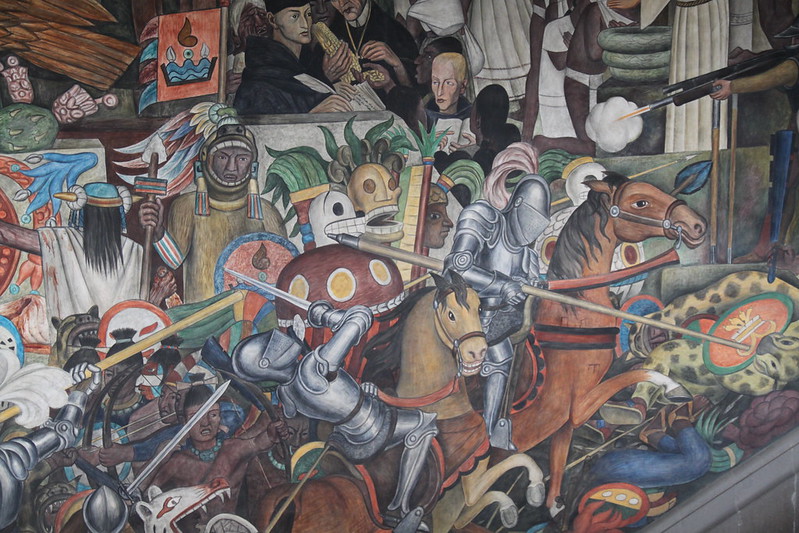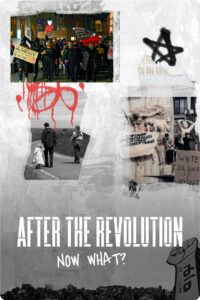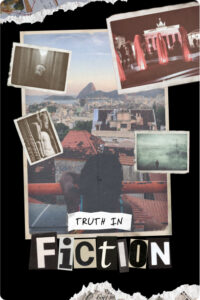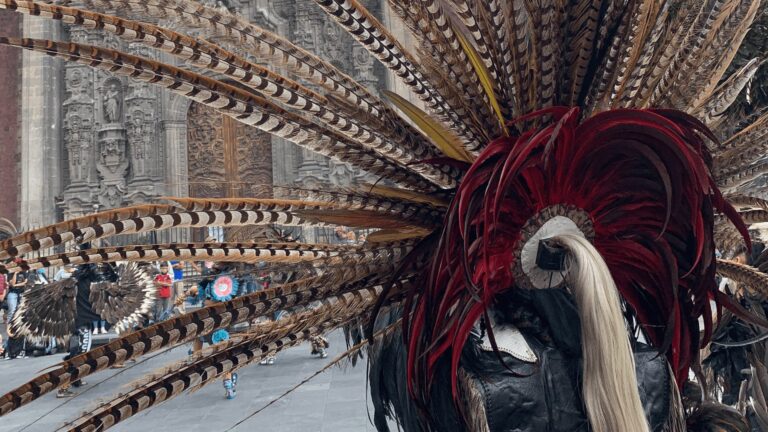I was born on a 12th of October in Mexico City. When I was just a child, the date didn’t mean much to me except that I was entitled to a party —as were the other children on their birthday. However, in the calendar’s monthly succession it implied I had to wait for mine almost until the end of the year, which felt like an eternity.
When I started elementary school, I discovered that October 12 was also a national holiday. I felt indirectly flattered: my birthday meant something to others. In exchange for the holiday, we had to memorize dates, historical events, as well as the names of the three ships —the caravels— on which Columbus and his crew had traveled: the Niña, the Pinta and the Santa María. It was also the day of the “Discovery of the Americas” and we did not attend school, so while all the other children celebrated their birthday in the classroom, mine was forgotten, almost by design, all because a European navigator had stumbled upon territory unknown to him, impacting entire civilizations. I wasn’t exactly suffering, but I didn’t hold Columbus in very high esteem either. Rather, I had a simmering grief that I believed was shared with the children who had their birthdays in the summer, and that —I was sure— no one ever remembered. I suspect this is the root of my nihilism regarding anniversaries and foolish recurring festivities.


That would imply a worthy twist for a day of national introspection
In any case, one year, while I was still in primary school, it was decided that October 12 would no longer be a national celebration. The discussions were heated, but at least everyone agreed that there was no such thing as a “discovery”, because there were already people leading their lives on the continent long before Europeans were around to witness it. Furthermore, different less-known sailors appeared to contest Columbus’s role as the first “foreigner” to set foot on the continent: the Viking Leif Erikson had been in the vicinity before, up north, in 1003; a Medieval prince of Wales, Madog Ab Owain Gwynedd, had reached the northern steppes escaping from a Civil War in 1170; the king of Mali, Abubakar the Second, was said to have sent an embarcation around 1310 that arrived to what is nowadays Brasil, and some speculate that even a chinese sailor, Zheng He, had touched land somewhere in Mexico between 1405 and 1433.
In any case, some politicians suggested that it was rather the opportunity to celebrate the Día de la Raza (“Day of the Race”), implying a celebration of original cultures —but even as a child, I could see this was a myopic, patronizing and even racist way of bringing indigenous cultures to the fore. To settle the issues, I tried to explain —to myself and to those who asked— that I was born on the day of the “encounter of worlds”, which was a more intellectualist nomination at the time. Here I was, thinking I had found a middle ground, being prudent and Solomonic, and could not see that this was closer to a naive embrace of mestizaje and the entire ideology that largely sustains the identity of a nation like Mexico. So I became a Mexicanist not out of love for the country, but by trying to turn the page, i.e. out of pure indecision and annoyance, as —I suspect— nationalisms eventually get under your skin.
Here I was, thinking I had found a middle ground […] So I became a Mexicanist not out of love for the country, but by trying to turn the page
Then came the celebrations of the 500 years of the arrival of Columbus to the New World, in 1992. I remember that there were many projects and expectations. I also remember Ridley Scott’s movie 1492. Conquest of Paradise, in which I saw what a caravel looked like for the first time, and I was struck by the swift succession of the Niña, the Pinta and the Santa María sailing the seas following the cadence of Vangelis’s music. However, shortly afterwards, the plans for the celebration were tempered, because in the end there really was not much to celebrate. I remember the criticisms, many of which Subcomandante Marcos masterfully summed up two years later in a fiery speech, when he raised his voice with the Zapatista Army and named that period “the long night of the 500 years”.
Around that time I stopped being interested in celebrating my birthday altogether and became more absorbed in better understanding the figure of Columbus. I found out that not much was actually known for sure. Ever since we were children and had to learn everything off by heart, we knew that Columbus was never aware that he had come across an entire continent, uncharted by European cartographies. He had settled for a little piece of an island, making trips to the neighborhood but never leaving his geographical comfort zone. He was never in Mexico, not even in Colombia, a country that allowed itself to be candidly named after him. All this we knew from the mythography classes we call history. What I did not know yet was that this man had been as cruel —or even more— than the men of his time. That he had founded in Hispaniola —the current island that Haiti and the Dominican Republic share— a colony that he ruled with greed and barbarism. Basically, Columbus had declared war against the Tainos, the local inhabitants. He had named them “cannibals”, that is, according to him, people of the Great “Khan” of Mongolia —a fanciful enemy of the Spanish crown— and hence he thought he had the right to terrorize them with contempt. He enslaved many of them. There were rapes, plundering, brutal excesses. The punishment for the slaves who did not meet the quotas to amass enough gold dust every three months was to have their hands cut off and be left to bleed to death. The punishment for the complainants and those who dared to insult him —indigenous or European— was to have their tongues cut out. Those who were not punished were reduced to an inhuman state. Thousands of natives preferred to poison themselves rather than perish in those conditions. Many more were killed by the new plagues of the old world: smallpox, measles, pertussis, chickenpox, bubonic plague, typhus and malaria. By 1500 —before Hernán Cortés and Francisco Pizarro’s forays of conquest had even begun on the mainland— Columbus and his brothers had already sent about 1,500 slaves to the markets of Europe. In 1501, the admiral obtained from the Catholic monarchs of Castilla y León the first license in history to ship African slaves to the coasts of the Caribbean. So Columbus did not discover the continent, but he was indeed the founder of the slave route in the Atlantic Ocean.
At one point, the excesses of the tyrant reached the ears of the crown in Castile, who ordered an investigation. A report, compiled by a certain Francisco de Bobadilla, a religious knight of the Order of Calatrava, mentions precise testimonies detailing the atrocities. Rediscovered just 15 years ago in Simancas, Spain, the report explains why Columbus was ousted and why there were never any official honors when he finally died. The admiral was not only an entrepreneur, but a man of exuberance and unbounded cruelty.
I lost track of Colón for several years. My birthday turned into an ordinary day of work and routine, and I began to complain about how little time I had to enjoy it. But recently the issue took a new turn. It happened as the questioning of certain historical figures came at the center of the protests stirred by the Black Lives Matter movement in the United States. They began with the most cynical characters in the southern states, General Robert E. Lee and the entire cohort of military, political and commercial assistants to the Confederate slaveholders. Soon the complaints involved the founders of several Ivy League universities, from Princeton to Harvard and Yale. It then touched upon the fathers of the nation —Washington, Jefferson, Franklin or Madison— who had to be assumed to be, if not as slave traders, at least slave owners, even though they had solemnly written in the declaration of independence —with some hypocrisy in light of the facts— that “all men are created equal”. The protests spread internationally, involving Edward Colston’s statue in Bristol, England, Cecil Rhodes and his colonial legacy in Zimbabwe and South Africa, Leopold II in Belgium, General Louis Faidherbe in Lille, France, etc. Back to Columbus, the protesters damaged and tore down statues of him in Boston, Saint Paul in Minnesota, Richmond in Virginia, and Camden in New Jersey. But things didn’t stop there, the discontent disseminated across the continent. In Arica, Chile, his statue was demolished in October 2019; in Barranquilla, Colombia, it was also brought down in June 2020, and in La Paz, Bolivia, the protesters attempted the same only in August 2021.


Obliterated by other problems —drug-cartel violence and the presidential obsession with projects of new infrastructures— those events had little echo in Mexico. Nonetheless, feminist collectives set out to draw attention to an urgent public situation by wrecking the symbols of the patriarchal state. Throughout 2019, historical monuments of all kinds were damaged during their protests on Paseo de la Reforma, one of the central avenues of Mexico City. Their claim was that women are more vulnerable and less protected than the statues they were vandalizing. No one in the government responded decisively to them, and only the Covid pandemic could make their fury subside. However, just in case, the city mayor, Claudia Scheinbaum, decided to remove the statue of Columbus that had marked that avenue for many years, and to place it somewhere where it was protected, apparently to be repaired. Just a few weeks ago, without public consultation or dialogue, it was announced that a new monument would be erected in its place. At first there was talk of a statue representing a woman, a postmodern yet reassuring neo-indigenous symbol. But then some voices spoke out against the sculptor, attacking him for being an opportunist who had nothing to do neither with the feminist movement nor with indigenous cultures. At this point, many journalists defended the history of the city and even the statue of Columbus, without even bothering to discuss the details or explain their arguments. Some others focused on the dubious and problematic choice of the sculptor, and on the way he was selected, without any form of public consultation. Finally, the media uproar was so piercing that the sculptor was discarded and a makeshift public works committee was put in charge of defining that another figure, the copy of a recently discovered Pre-hispanic monolith representing a princess, would be placed there. Within the new set of plain contradictions —why a copy? why a representation of the elites once again?— the discussion about Columbus’s legacy —or his responsibility in reprehensible events— simply faded away.
October 12 has passed once again this year, just like any other day, nowhere near turmoil nor triumph. Unfortunately, it entailed yet another foregone opportunity to dispassionately examine the national symbols. The day dedicated to Columbus has long since disappeared from official history, so children nowadays don’t have to imagine what a caravel is. But whatever happened with Columbus, or for that matter, with Cortés, or the indigenous groups that defeated the Aztecs, is never discussed with enough detail and depth. At least Columbus did not set foot on these lands. But Cortés did: he landed in the Gulf coast of Veracruz on April 21, 1519. Many still think —perhaps because it is in the interest of the government to cultivate the figure of an abstract and simplistic archenemy— that he alone led a handful of Spaniards to conquer an entire empire. But neither logic nor facts stand on the side of these dogmatic repeaters.
Help us tell the world to you !
Frictions is launching its club : by supporting Frictions, you’ll be supporting a community of authors and journalists who tell the world through intimate stories!

Today we know that it was thanks to the Tlaxcalans, the Totonacs, the Tetzcocans and many other local groups that a new order was installed in these territories, under a bureaucracy that we insist on calling colonial. It was they, hand in hand with the new European ideologues and spearheads, who spread the new vision, the new worldview, the new lingua franca that Spanish became. It is not a simple story, because it is enmeshed in the complexities of real life and not the pastiche that opposes the martyrs and the wicked. And as Mexican writer Carlos Fuentes argued in The Buried Mirror: “I suspect that (…) we have sought or imposed too frequently models of development without much relation to our cultural reality.” In the end, we need to come to terms with a multifaceted narrative that will inevitably be more complex. But now it should be up to those born on April 21 to remind us of this pending matter. That would imply a worthy twist for a day of national introspection. The day of the landing of Cortés, thirteen years after Columbus had already died, was to become a caesura in the evolution of an old cosmogony, and was to forever alter in this geography a certain way of understanding the intersections of life and death, time and eternity.









